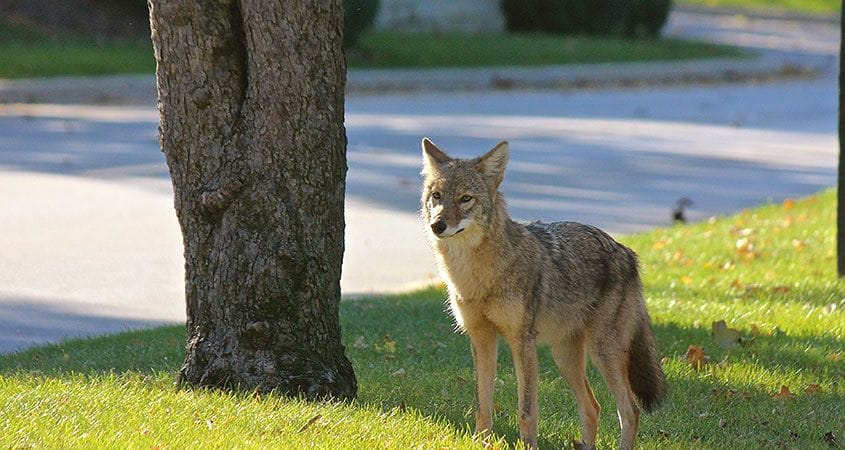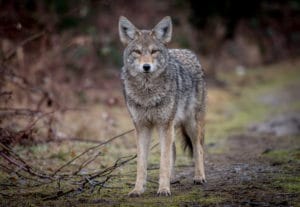If you live in a rural area, then you’re probably already aware of possible wildlife dangers from predators like mountain lions and coyotes. And if you live in a big city, you might think that such threats are the last thing you’d have to worry about — but you’d be wrong. For example, in some places in the southwestern U.S., mountain lions prowl the city streets with one of them, P-22 in Los Angeles, becoming a local celebrity.
But in this article, we’re discussing coyotes, which are even more prevalent in cities than mountain lions. They live throughout Canada, the U.S., and Mexico, and even range into Central America. They are highly adaptable predators, living in territories including plains, forests, mountains, and deserts. By this point, they also live in most major American cities including places as diverse as Los Angeles, Chicago, New York, Atlanta, and>Dallas.
In fact, the only U.S. state without known coyote populations is Hawaiʻi — but that doesn’t mean they won’t show up there eventually.
And in describing coyotes as living in cities, we really mean “in.” Because urban zones provide everything they need, from dens to sources of food and water, they’re just as likely to be found in a concrete canyon as in an urban park or city-adjacent countryside.
How Dangerous Are Coyotes?
The good news is that when it comes to people, coyotes aren’t that dangerous. There has only been one known human death in the U.S. in the last thirty-six years, although there have been a number of attacks over the same four decades.
The good news is that coyotes prefer a natural diet over snacking out of our dumpsters — or on our pets. The bad news is that coyotes are losing their natural aversion to human beings and while your small dog or cat won’t be their first choice for meal time, that doesn’t mean that they won’t carry one off given the opportunity.
In assessing the danger, we do need to also be aware of several myths about coyotes. For example, while they tend to be pack animals, they don’t always live in packs. A typical coyote pack has an alpha male and female, often one of their older offspring from a previous litter as a “helper,” and the current litter of pups. But young coyotes, particularly alpha males who have lost their mates, will sometimes live and hunt alone, and up to a half of all coyotes studied in the Urban Coyote Research Program were solitary.
Another myth is that if you see a coyote during the day it indicates that there is something wrong — like the coyote is diseased or the pack is in distress. This isn’t necessarily true, since coyotes tend to be diurnal (active by day) or crepuscular (active at sunrise and sunset).
The best way to prevent problems with coyotes, of course, is to not leave them any resources. Don’t leave out pet food or water bowls, make sure that compost heaps are in secured containers, and consider installing coyote rollers on your fences if they’re a problem in your neighborhood.
Protecting Your Dog from Coyotes on the Walk
So what should you do if you’re walking your dog and you run into a coyote? The simplest and best advice is this: Avoid the situation. But the avoidance doesn’t begin when you see a coyote. It begins when you take steps to prevent encounters in coyote country.
First and foremost, always keep your dog on a lead on the walk, and make sure that lead is no longer than 6 feet (1.83 meters). This will keep your dog under your control and allow you to pull him or her out of harm’s way if necessary. You especially do not want to use any kind of variable-length lead, particularly not if you have small dogs.
Next, if there are known nesting and breeding areas in your neighborhood, avoid them, particularly during and just after mating season. This runs from late December through spring, with pups being born anywhere from late January through July. Coyote gestation — the period from conception to birth — is a mere 60 to 63 days, which is similar to a dog’s.
When you’re walking, try to stick to open areas and trails, and avoid places with thick brush, where coyotes may be hanging out. This will minimize your chance of running into a coyote unexpectedly.
Finally, avoid taking your walk around sunrise or sunset, which are times when coyotes may be particularly active.
What if You Run into a Coyote?
Your approach to a coyote depends on whether it’s during that mating and breeding season, so the rules are different from August to January than they are from January to July.
Off-Season (August to January)
The best approach during this or any time of year is avoidance. If you see the coyote in the distance and can change your route to avoid it, then do so. The coyote is probably not going to try to track and hunt you and will be just as grateful for the missed encounter.
However, if the encounter happens suddenly or you otherwise don’t have a chance to avoid and it isn’t breeding season, then you’ll have to scare the coyote off. After making sure you have control of your dog — picking up small dogs and hiding them under a sweater, coat, or shirt if necessary — stand tall and assertive and face the coyote. Maintain eye contact and don’t turn away. It is especially important to not run away, because this can trigger the coyote’s prey drive.
To scare the coyote off, you can yell, stomp your feet, or use some physical display — for example, opening and closing an umbrella if you have one, or waving a jacket at them. You can also throw stones or branches toward — but not at — the coyote to startle them and make them run. Ultimately, you will want to walk away from them, but do it in a way where you can maintain that eye contact while making it clear you’re leaving the territory they’re protecting.
One other important point, as noted by the Urban Coyote Initiative: if a coyote seems too brave and unwilling to be scared off, report it to local animal control. This could indicate that the coyote has become too used to humans, or even that it’s being fed by somebody, which is something that should never be done. This can lead to the coyote becoming aggressive toward people.
Birthing Season (January to July)
During this time of year, you do not want to harass or scare the coyote off, as they may perceive this as a threat to their pups and will go on the offensive. Instead, you want to walk away calmly and slowly while never turning your back on the coyote but remaining assertive with your body language and energy. Walk backwards if necessary.
In these cases, the coyote may follow you for a while. This is so they can make sure you’re leaving their territory. This is also why you don’t want to turn your back on them, because this may induce them to get a lot closer in order to hurry up your exit. The trick is to respect them and their den while also showing that they are not intimidating you.
Once upon a time, city and country were very distinct things, with the wildlife of one rarely encroaching on the urban life of the other. But, as time goes by and our cities expand and take up more formerly natural habitats, all of that wildlife has to go somewhere. The most adaptable animals, like coyotes, wind up moving onto our city and suburban streets with us.
They can’t help it. They’re only trying to survive. That’s why it’s our responsibility to not encourage them to get too comfortable, and to take what steps we can to keep encounters to a minimum.
What wildlife issues do you have in your area and how do you keep your dogs safe on the walk and at home? Let us know in the comments!











